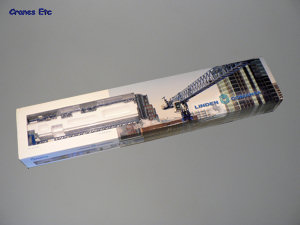 | | A very long and thin box with a partial window. |  | 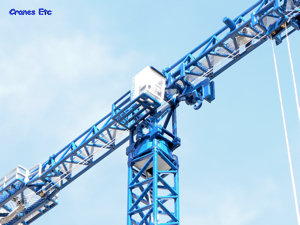 | | Detail at the cab. White string looks a little odd. |  | | Chunky concrete skip. | 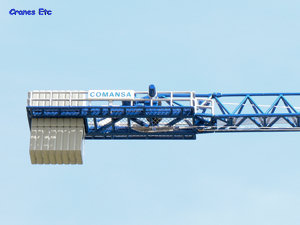 | | Counter jib detail. The spring is to tension the trolley operating mechanism. | 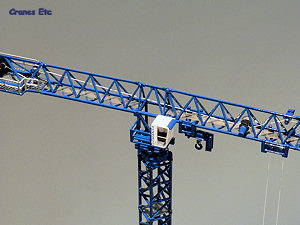 | | Second trolley and hook. |
| This is the second 1:87 tower crane model from the Italian model maker Ros Agritec. The model is of a Spanish Linden Comansa tower crane, and is a 'Topless' model designated the 21 LC 290.
Packaging
The model comes in a very long thin box. This is because the jib and counterweight section are preassembled as one piece measuring over 94cm (37 inches). It is packed within an expanded polystyrene tray and the model is well protected. The review model had one broken piece but this was easily fixed.
No instructions were included with the review model and although it is straightforward to build there are some floodlight fittings supplied in a small bag and it is not obvious where they should be fitted. One slightly strange aspect when placing the crane on the mast is that only three of the four connections are screwed, the fourth is just a locating pin.
Detail
At the base, the model screws onto a black plastic base plate to provide extra stability to the model and this works quite well. The cruciform arrangement at the base is all metal and includes an access ladder to get into the mast. The ballast blocks are concrete coloured and are solid pieces with grooving detail to give the appearance of being separate slabs.
A detailed capacity board completes the detail at the base. The mast is provided as a single piece representing eight separate mast sections and includes plastic ladders to match each section, with intermediate platforms. At the top of the mast is the slewing ring and a slewing motor is modelled. There is no ladder leading to the cab platform which is a pity and the platform itself lacks a mesh walkway of the sort provided elsewhere on the model. The cab is small with a seat inside.
The counterweight jib is made up of two pieces, a fully triangulated section and a machinery deck and counterweight support. Although made of separate sections they are not designed to be dismantled. An excellent feature of the counterweight jib is the mesh walkway flooring. Two gauges are used, with the finer gauge being the most realistic for the scale. Handrailing is good but perhaps inevitably not fine enough for the scale of the model. An electrical cabinet and winch motor complete the detail. The counterweight block is a single solid piece, with grooving in the casting to give the appearance of separate concrete slabs.
The main jib is made up of six separate fully triangulated sections but again they are not designed to be separated. The method of joining the sections together does result in a small downstand piece at each join but this is not too obtrusive. Overall the geometry of the review model was very good with the jib being straight and true to a high degree which is a significant achievement. A trolley motor is fixed to the first jib section and the various pulleys on the superstructure are brass. Fine mesh walkways extend the length of the jib. A set of floodlights are provided in a bag with the model and they can be fitted to the jib to provide lighting as favoured in some countries.
The trolley is metal and a second dummy trolley is located adjacent to the cab. The hook block is good and includes two tiny brass pulleys and a separate hook. Strangely white string has been chosen for the model. A black colour and a thinner string would look much better and some collectors will be tempted to change the string on the model accordingly.
A metal concrete skip is provided which adds weight to keep the hoist rope taught. It is perhaps a bit too heavy and large for the model.
Features
The model features raising and lowering the hook using the winch although there is not enough string on the model to allow the hook to reach ground level. Also there is not much friction in the winch so it cannot hold a load without unspooling.
The crane can rotate fully and smoothly, and is stable throughout. It also has a working trolley which moves by turning the winch on the trolley motor. It actually works quite well with the tension in the towing ropes maintained by a spring although the size and location of the spring could have been better.
Quality
This is quite a well made model with some fine casting and good paint work. The working trolley mechanism enhances the model.
Price
Ros have produced a very good value model at an economic price compared to other similar models.
Overall
This is a good looking 1:87 tower crane from Ros which moves forward the benchmark in this scale. The model is large and some collectors will be challenged finding space for it. For this reason it would have been really good if the model could have been designed to be split into smaller pieces either to show it in a smaller configuration or as transport loads. It is certainly recommended as it is however.
Footnotes
The model was announced in September 2006 and was shown at the Nuremberg Toy Fair in February 2007.
|
| |
|  | | Inside the box the mast and jib sections are preassembled. | 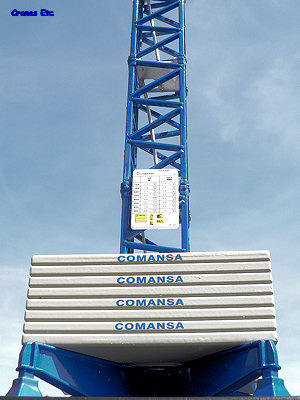 | | Weights at the base and capacity board on the mast. | 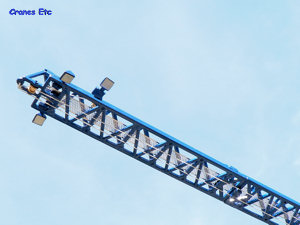 | | Jib end with lights attached. | 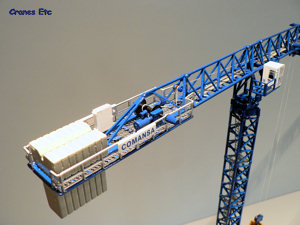 | | Motor details and mesh walkways on the counterjib. |
|

